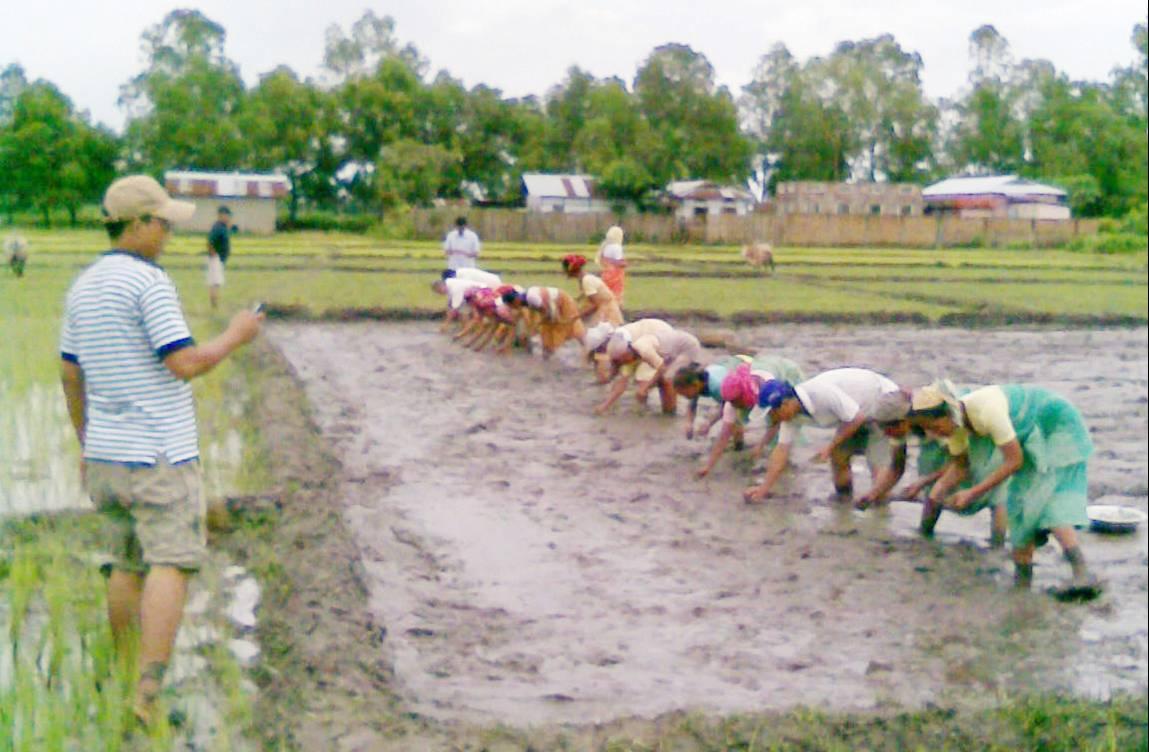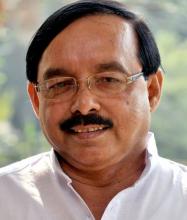Rice is the staple food in the North East Region. Cultivation of rice in the region is mostly rainfed though irrigation also prevails. Increase in food grain production is required to meet demands of increasing population. The drought like situation during crop season necessitates the farming community to be aware and adapt to recent advances on reduced water use for sustained rice production.
The actual amount of water used by farmers for land preparation is often several times higher (1200-1500 mm) than the typical requirement (150–250 mm). Several factors cause this high water use. Typical wetland preparation for rice culture involves supplying adequate amounts of water to saturate the soil (land soaking) and to maintain a wet soil condition that facilitates ploughing, harrowing, puddling, and land leveling so that transplanting of seedlings can be done easily. In the beginning of the season, land soaking often involves applying water on cracked soils that resulted from soil drying during the fallow period after the harvest of the previous crop. In our normal practices, about half of this applied water move through the cracks, bypassing the topsoil matrix, and flow to the surroundings through lateral drainage. However, water loss becomes higher when farmers take a long time to complete land preparation.
During the crop growth period, the amount of water usually applied to the field is often much more than the actual field requirement. This leads to a high amount of surface runoff, and seepage and percolation.
In traditional transplanted rice, farmers prefer to maintain a relatively high depth of water in order to control weeds and reduce the frequency of irrigation (and hence labor cost). Percolation rate increases as the depth of water standing in the field increases.
In rice irrigation systems where the plot-to-plot method of water distribution predominates, farmers have to build up the water head at the upper end of the farm to ensure the flow of water, which is often accompanied by excessive percolation. Underbund percolation could cause a further 2-5 times increase in percolation rate, depending on the size of the field. Underbund percolation results from lateral movement of ponded water into the bunds and then (because of the absence of a semi-impermeable layer under the bunds) vertically down to the soil.
Study conducted at IRRI shows the effects of the various factors on conveyance, field channel, and distribution efficiencies and indicates that only 30–65 percent of the water released at the headworks reaches the intended field inlets.
In order to overcome inefficient water management practices in rice culture, several new technologies have been developed. There may be potential for increasing on-farm water productivity by increasing yield per unit evapotranspiration during crop growth; reducing evaporation, especially during land preparation; reducing seepage and percolation during the land preparation and crop growth periods; and reducing surface runoff. Introducing management practices and infrastructure improvements that result in either of the first two will increase the efficiency of the system and the basin. The potential of the last two for system and basin productivity depends on opportunities for and costs of recycling at downstream locations.
Adoption of improved, early maturing, high-yielding varieties of rice during the past two decades has increased the average yield of irrigated rice from 2–3 t per hectare to 5–6 t per hectare and reduced crop duration from about 140 days to about 110 days. This has contributed to a 2.5-3.5-fold increase in water productivity with respect to evapotranspiration. The availability of hybrid varieties, which have 15–20 percent higher yield potentials than inbred high-yielding rice of comparable maturity periods, offers another opportunity for increasing water productivity in rice culture. Better soil nutrient management results in higher yield although the amount of water consumed by rice remains almost unchanged. Proper weed management also helps increase water productivity. Another way to increase economic productivity per unit of water for transpiration is to shift to higher-valued crops.
In traditional practice, excessive amount of water is used in land preparation. Reducing the period of land preparation would lead to substantial savings in water, including water lost because of evaporation, seepage and percolation, and surface runoff. The time needed for distributing water in the field can be shortened significantly by using more field channels instead of the plot-to-plot method. The amount of bypass flow can be reduced by measures that restrict the formation of soil cracks or impede the flow of water through the cracks. Shallow, dry tillage soon after harvesting the previous rice crop is an effective strategy for minimizing the formation of soil cracks and occurrence of bypass flow. The tilled layer acts as mulch and therefore reduces soil drying and consequent cracking. In soils that already have cracks, dry tillage produces small soil aggregates that block the cracks, thereby reducing bypass flow.
In recent years, there has been a shift from transplanted rice to the direct-seeded (i.e., sowing seeds directly on rice fields) method of crop establishment in several countries in Southeast Asia. This change has emerged because of the acute farm labor shortage and consequent increase in wages for transplanting operation. This shift from transplanting to direct seeding, however, offers opportunities to improve water-use efficiency in rice culture by reducing the irrigation inflow requirement during land preparation. There are two forms of direct-seeded rice: wet seeding and dry seeding. In wet-seeded rice (WSR), pre germinated seeds are broadcast on saturated and usually puddled soil. In contrast, dry-seeded rice (DSR) is grown by sowing ungerminated seeds on dry or moist but unpuddled soil. Total water requirement in WSR systems drop by 20-25% over traditional method. In WSR, seeds require only 24–36 hours of soaking and incubation to be ready for sowing in the field. In contrast, in the transplanted-rice system, seedlings are usually nurtured in the seedbed for about 1 month and therefore farmers have no reason to complete land soaking, plowing, and harrowing activities until the seedlings are ready. Because there is a high risk of lodging with WSR, farmers maintain a shallower water depth in their fields than for transplanted rice and this results in less percolation. However, maintaining a shallow water depth is not unique for WSR.
In DSR, early premonsoon rainfall is used effectively for crop establishment and during the early stage of crop growth. Later in the season, when the reservoir has been filled and irrigation has begun, the crop can be irrigated as needed. Early crop establishment results in early harvest of the first crop. This permits a reduction in irrigation inflow requirements from reservoirs in the wet season, leading to an increase in the availability of water in the dry season. DSR required less water for land soaking than WSR, and WSR required less than transplanted rice. However, direct seeded rice has some shortcomings such as - poor germination (in unleveled land) and profuse weed growth which result in reduction in rice yield.
Puddling the soil during land preparation is an effective way to reduce percolation during crop growth. Puddling causes the formation of a semi-impermeable layer with a very low hydraulic conductivity beneath the puddled topsoil. Puddling can reduce input water by 40–60 percent during crop growth because of the reduced percolation rate. Underbund percolation can be minimized by reducing lateral infiltration into the bunds. During land preparation, farmers seal bund walls with clay taken from the plow layer. Continuous submergence is not essential for obtaining high rice yields. Maintaining a very thin water layer, saturated soil condition, or alternate wetting and drying could reduce water applied to the field by about 40–70 percent compared with the traditional practice of continuous shallow submergence, without a significant yield loss. In general, the lighter the soil, the greater the reduction in water needed for the rice field when these water-saving irrigation (WSI) techniques are used. The shallower the groundwater table, the longer the interval between irrigations. Farmers often practice continuous submergence of rice fields to reduce weed problems. In situations where weed pressure was high, continuous submergence up to the panicle initiation stage followed by continuous saturation requires 35 percent less water input than continuous flooding, without any yield reduction or increase in weed infestation.
It is highly expected that with the farming community will go in hand with improvements in technologies for water reduction in rice culture. It may be observed from the discussion that the technologies offered can be adopted by the farmers with ease with prior understanding of various components and processes responsible for inefficiency of water use. The method of direct seeding of rice is also expected to reduce drudgery of the farmers and help in timely completion of agricultural activities without depending much on hired labourer for transplanting. This reduction in drudgery is also expected to encourage the farmers to go for second rice crop, over the prevailing practice of mono cropping in the entire North East Region of India.
(with help of resources from International Rice Research Institute, Phillipines and International Water Management Institute, Sri Lanka)






Comments
Pages
Add new comment